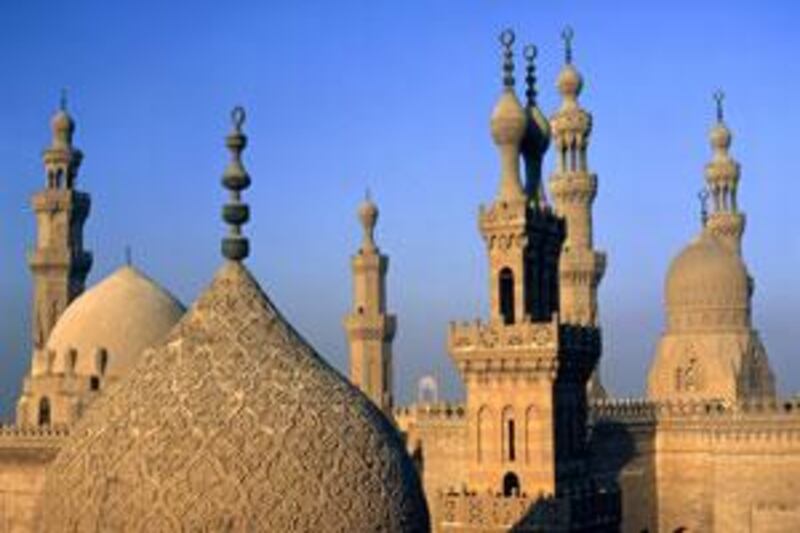Known as al Qahirah or "the victorious" in Arabic, Cairo is one of the pre-eminent cities in world history, and has played a central role in human events from the founding of monotheism to the formation of the modern Middle East. Few cities in the world can claim to be home to a more rich, diverse and visible history. Ben Ezra, the 9th-century synagogue, was built near the spot where the Old Testament states that baby Moses was found, floating among the reeds of the Nile. It lies only hundreds of metres away from Africa's oldest mosque, the Mosque of Amr ibn al As, built only years after the death of the Prophet Mohammed. Between the two buildings is a church built above the cave where, according to the Bible, an infant Jesus and his mother Mary took shelter. You can still pull up a pail of water from the well there and drink from it. And that's not to mention the only remaining ancient wonder of the world, the Great Pyramid of Giza, which stands only a few kilometres away. Co-existing alongside this overdose of history is the most vibrant city in today's Middle East. Beirut may move ahead in terms of hedonistic nightlife, but Cairo easily has the edge when everything else is taken into consideration - from the sheer mass of humanity bustling in its alleyways in the city's mediaeval quarters, to the city centre with its chic, modern developments. Those interested in Islamic architecture will find some of the world's finest here, and Arabists can immerse themselves in it, from the Old City's streets to Downtown's coffee shops and the impressive range of museums and cultural centres.
Cairo is truly the city that never sleeps. There is something to do any time of the day or night but if you don't know how to get started then simply begin by roaming around Downtown Cairo where some of the most interesting architecture can be found. This area reflects the wishes of Khedive Ismail, who ruled Egypt and Sudan until 1879, to build a "Paris along the Nile". His dream can be seen in the heavy European influence in the elegant buildings. From there, you can walk to the Egyptian Museum, home to the most extensive collection of Egyptian antiquities in the world, including 27 royal mummies and many of King Tutankhamun's treasures. Setting eyes on the Great Pyramids of Giza and the Sphinx is always a thrill, but make sure that you also arrange to see the nightly Pyramids' Sound and Light Show, which tells the story of how the pyramids were built. Don't leave Cairo without visiting some of the world's oldest and most prized mosques. The Sultan Hassan Mosque and Madrasa on El Qalaa Street dates back to the mid-1300s and is, perhaps, the most important Islamic monument in Egypt; a masterpiece of early Mamluk architecture, in which each of the four schools of Sunni Islam has an area. And just across from the Al Azhar Mosque, built in 972, you will find the Khan al Khalili bazaar, where you can find everything from handmade ornaments to spices and belly -dancing costumes. As for nightlife, Cairo offers plenty of action. As the sun sets, head to Sequoia, Cairo's best café on the Nile and one of the most beautiful riverside lounges in the world. Located on the tip of the trendy island of Zamalek, the views are as gorgeous as the 50 flavours of -shisha tobacco, oven-fresh bread and its great Arabic meze. And when finally you are ready to pack your bags and leave Cairo, remember the Egyptian saying: "Once you drink from the Nile, you will always come back."
Budget Located in the heart of Downtown Cairo, the two-star Lotus Hotel is in one of the most convenient bases for easy access to a large number of traditional Egyptian restaurants, bars and shops. The hotel is also a 10-minute walk to the Tahrir metro station and the Egyptian Museum. The rooms are a little bit worn around the edges but the location and the price makes it ideal for travellers on a shoestring. A double room with breakfast costs from US$29 (Dh106)per night. The Lotus Hotel, 12, Talaat Harb Street (www.lotushotel.com; 0020225750966). Mid-range Scenes from the well-known Egyptian film, The Yacoubian Building, were shot at the Windsor Hotel. This three-star hotel hasn't changed much since it was built in 1901 - from the dark hardwood floors to the barrels which are used at seats in the bar area and perhaps one of the oldest metal elevators in Cairo. So if you're looking to feel transported to earlier times, then the Windsor is the place for you. Double rooms cost from $74 (Dh270) per night including breakfast. The downstairs cafe and bar has wifi. The Windsor Hotel, 19 Alfi Bey Street (www.windsorcairo.com; 00 20 2 25915277). Luxury Once the hunting palace of King Farouk, Mena House Oberoi is one of the oldest luxury hotels in Egypt. The hotel first opened in 1869 and is set among 16 hectares of gardens with the Great Pyramids of Giza in the backdrop. The Mena House has 523 rooms and suites split between two sections; the original palace wing and the newer garden wing. The lovely property is furnished with traditional arabesque furniture, handcrafted mosaic tiles and carved brass-bound wooden doors. Double rooms cost from $306 (Dh1,144). The Mena House Oberoi, Pyramids Road, Giza (www.oberoimenahouse.com; 0020 2 33773222).
Breakfast For a truly Egyptian breakfast in the heart of the Downtown area head to Prince, which is located next to Cairo's stock exchange, known locally as the Borsa. Here you can try foul - a fava bean dish that is a must-eat in any Egyptian household along with falafel and other breakfast staples. As a side note, if you happen get a craving for foul past midnight, there is no better or authentically Egyptian place to get your fix than Mahrous, which is open from 4pm to 4am. Tucked away in the innards of Garden City, not far from the Canadian Embassy, lies this unassuming foul stand, complete with an edra, a special steel pot used for cooking foul. Don't let the humble plastic chairs and plain wooden tables deter you - what comes out of that edra is some of the finest foul in Cairo. Hearty meals at either restaurant cost from around $2 (Dh7). Mahrous, 4 Al Haras Street, -Garden City . Lunch Koshari is a popular traditional Egyptian dish. It consists of rice, brown lentils, chickpeas and macaroni. Garlic and vinegar, spicy tomato sauce, fried onions (or all of the above) are commonly added on top according to one's preference. To eat some of the best koshari in Cairo, you have to visit Koshari el Tahrir. A good-sized portion of koshari for one costs around $1.40 (Dh3.3). El Tahrir Street, at the corner of Youssef el Guindi (around the corner from The American University of Cairo's Greek Campus ). Dinner With the ambiance and decadence of old Cairo, Le Caire 1940 is a great place to enjoy a warm, homely dinner. Try some of Egypt's oldest recipes that hark back to Ottoman rule. Classic dishes include moloukhiya - or jute plant soup - and sharkasiya, a Turkish dish made of rice, chicken and walnuts and a thick cream sauce. Either will cost around $15 (Dh53). Le Caire 1940, 17 Hassan Sabry Street, Zamalek (002 7355 226).
Fly from Abu Dhabi to Cairo from $632 (Dh2,320) return including taxes with Etihad (www.etihad airways.com).
The Cairo Trilogy by Naguib -Mahfouz should be on the list of anyone who wants to become familiar with life in Cairo. Many consider Cairo: The City Victorious by Max Rodenbeck a must-read. abakr@thenational.ae





